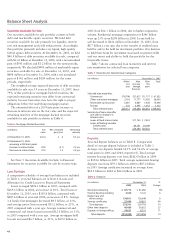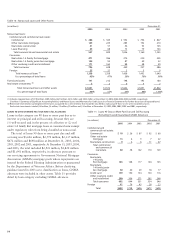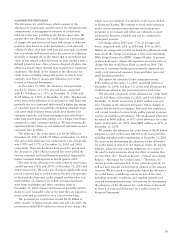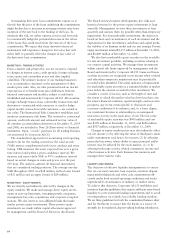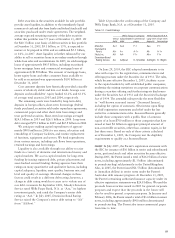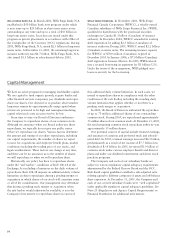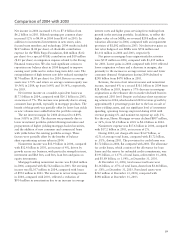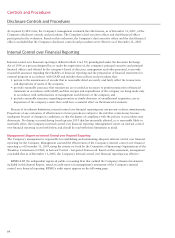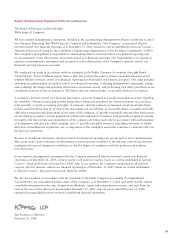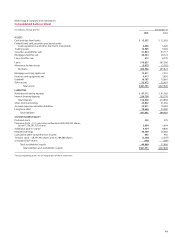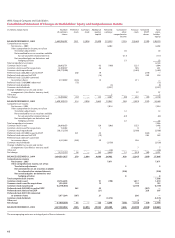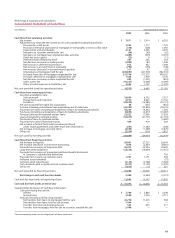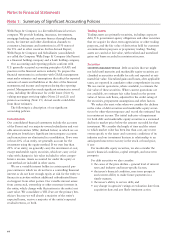Wells Fargo 2005 Annual Report Download - page 57
Download and view the complete annual report
Please find page 57 of the 2005 Wells Fargo annual report below. You can navigate through the pages in the report by either clicking on the pages listed below, or by using the keyword search tool below to find specific information within the annual report.
55
Debt securities in the securities available for sale portfolio
provide asset liquidity, in addition to the immediately liquid
resources of cash and due from banks and federal funds sold and
securities purchased under resale agreements. The weighted-
average expected remaining maturity of the debt securities
within this portfolio was 5.9 years at December 31, 2005. Of
the $40.3 billion (cost basis) of debt securities in this portfolio
at December 31, 2005, $5.1 billion, or 13%, is expected to
mature or be prepaid in 2006 and an additional $5.5 billion,
or 14%, in 2007. Asset liquidity is further enhanced by our
ability to sell or securitize loans in secondary markets through
whole-loan sales and securitizations. In 2005, we sold mortgage
loans of approximately $435 billion, including securitized
home mortgage loans and commercial mortgage loans of
approximately $190 billion. The amount of mortgage loans,
home equity loans and other consumer loans available to
be sold or securitized was approximately $150 billion at
December 31, 2005.
Core customer deposits have historically provided a sizeable
source of relatively stable and low-cost funds. Average core
deposits and stockholders’ equity funded 63.2% and 63.1%
of average total assets in 2005 and 2004, respectively.
The remaining assets were funded by long-term debt,
deposits in foreign offices, short-term borrowings (federal
funds purchased, securities sold under repurchase agreements,
commercial paper and other short-term borrowings) and
trust preferred securities. Short-term borrowings averaged
$24.1 billion in 2005 and $26.1 billion in 2004. Long-term
debt averaged $79.1 billion in 2005 and $67.9 billion in 2004.
We anticipate making capital expenditures of approxi-
mately $900 million in 2006 for our stores, relocation and
remodeling of Company facilities, and routine replacement
of furniture, equipment and servers. We fund expenditures
from various sources, including cash flows from operations,
retained earnings and borrowings.
Liquidity is also available through our ability to raise
funds in a variety of domestic and international money and
capital markets. We access capital markets for long-term
funding by issuing registered debt, private placements and
asset-backed secured funding. Rating agencies base their
ratings on many quantitative and qualitative factors, including
capital adequacy, liquidity, asset quality, business mix and
level and quality of earnings. Material changes in these
factors could result in a different debt rating; however, a
change in debt rating would not cause us to violate any of
our debt covenants. In September 2003, Moody’s Investors
Service rated Wells Fargo Bank, N.A. as “Aaa,” its highest
investment grade, and rated the Company’s senior debt
rating as “Aa1.” In July 2005, Dominion Bond Rating
Service raised the Company’s senior debt rating to “AA”
from “AA(low).”
Table 12 provides the credit ratings of the Company and
Wells Fargo Bank, N.A. as of December 31, 2005.
Table 12: Credit Ratings
Wells Fargo & Company Wells Fargo Bank, N.A.
Senior Subordinated Commercial Long-term Short-term
debt debt paper deposits borrowings
Moody’s Aa1 Aa2 P-1 Aaa P-1
Standard &
Poor’s AA- A+ A-1+ AA A-1+
Fitch, Inc. AA AA- F1+ AA+ F1+
Dominion Bond
Rating Service AA AA(low) R-1(middle) AA(high) R-1(high)
On June 29, 2005, the SEC adopted amendments to its
rules with respect to the registration, communications and
offerings processes under the Securities Act of 1933. The rules,
which became effective December 1, 2005, facilitate access
to the capital markets by well-established public companies,
modernize the existing restrictions on corporate communications
during a securities offering and further integrate disclosures
under the Securities Act of 1933 and the Securities Exchange
Act of 1934. The amended rules provide the most flexibility
to “well-known seasoned issuers” (Seasoned Issuers),
including the option of automatic effectiveness upon filing
of shelf registration statements and relief under the less
restrictive communications rules. Seasoned Issuers generally
include those companies with a public float of common
equity of at least $700 million or those companies that have
issued at least $1 billion in aggregate principal amount of
non-convertible securities, other than common equity, in the
last three years. Based on each of these criteria calculated
as of December 1, 2005, the Company met the eligibility
requirements to qualify as a Seasoned Issuer.
PARENT. In July 2005, the Parent’s registration statement with
the SEC for issuance of $30 billion in senior and subordinated
notes, preferred stock and other securities became effective.
During 2005, the Parent issued a total of $16.0 billion of senior
notes, including approximately $1.3 billion (denominated
in pounds sterling) sold primarily in the United Kingdom.
Also, in 2005, the Parent issued $1.5 billion (denominated
in Australian dollars) in senior notes under the Parent’s
Australian debt issuance program. At December 31, 2005,
the Parent’s remaining authorized issuance capacity under its
effective registration statements was $24.8 billion. We used the
proceeds from securities issued in 2005 for general corporate
purposes and expect that the proceeds in the future will
also be used for general corporate purposes. In January and
February 2006, the Parent issued a total of $3.6 billion in senior
notes, including approximately $900 million denominated
in pounds sterling. The Parent also issues commercial paper
from time to time.



